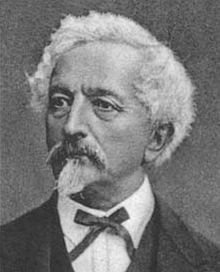Ascanio Sobrero
This article needs additional citations for verification. (September 2014) |
Ascanio Sobrero | |
|---|---|
 Ascanio Sobrero | |
| Born | 12 October 1812 |
| Died | 26 May 1888 (aged 75) Turin, Italy |
| Nationality | Italian |
| Alma mater | University of Gießen |
| Known for | discovery of nitroglycerine |
| Scientific career | |
| Fields | Organic chemistry |
| Institutions | University of Gießen, University of Turin |
| Doctoral advisor | Justus Liebig |
Ascanio Sobrero (12 October 1812 – 26 May 1888) was an Italian chemist, born in Casale Monferrato. He studied under Théophile-Jules Pelouze at the University of Turin, who had worked with the explosive material guncotton.
He studied medicine in Turin and Paris and then chemistry at the University of Gießen with Justus Liebig, and earned his doctorate in 1832. In 1845 he became a professor at the University of Turin.
During his research he discovered, in 1847, nitroglycerine.[1][2] He initially called it "pyroglycerine", and warned vigorously against its use in his private letters and in a journal article, stating that it was extremely dangerous and impossible to handle. In fact, he was so frightened by what he created that he kept it a secret for over a year.
Another of Pelouze's students was the young Alfred Nobel, who returned to the Nobel family's defunct armaments factory and began experimenting with the material around 1860; it did, indeed prove to be very difficult to discover how to handle it safely. In the 1860s Nobel received several patents around the world for mixtures, devices and manufacturing methods based on the explosive power of nitroglycerine, eventually leading to the invention of dynamite, ballistite and gelignite from which he made a fortune.
Although Nobel always acknowledged and honoured Sobrero as the man who had discovered nitroglycerine, Sobrero was dismayed by the uses to which the explosive had been put and claimed he was almost ashamed by his discovery.[3]
Works
[edit]
- Manuale di chimica applicata alle arti (in Italian). Vol. 1. Torino: Pomba. 1851.
- Manuale di chimica applicata alle arti (in Italian). Vol. 2. Torino: Pomba. 1853.
- Manuale di chimica applicata alle arti (in Italian). Vol. 3. Torino: UTET. 1856.
- Baroscopio o prenunziatore del tempo (in Italian). Torino: Camilla & Bertolero. 1864.
- Vetri e cristalli (in Italian). Torino: Dalmazzo. 1865.
- Manuale di chimica applicata alle arti (in Italian). Torino: UTET. 1866.
- Della cagione della malattia della vite e dei mezzi da usarsi per debellarla (in Italian). Torino: Stamperia reale. 1867.
- Sulla preparazione dei legnami col bitume residuo della raffinazione del petrolio (in Italian). Torino: Stamperia reale. 1868.
- Dei cementi magnesiaci (in Italian). Torino: Favale. 1869.
- Sul calcare bituminoso di Manopello (in Italian). Torino: Favale. 1869.
- Esame della foglia del gelso (in Italian). Torino: Stamperia reale. 1871.
- Della cagione della malattia del baco da seta (in Italian). Torino: Stamperia reale. 1871.
- Analisi delle calamine (in Italian). Torino: Stamperia reale. 1871.
- Conservazione dei legnami col mezzo del bitume residuo della raffinazione del petrolio (in Italian). Torino: Stamperia reale. 1871.
- Intorno alla malattia dominante del baco da seta (in Italian). Torino: Foa. 1872.
- Pensieri agronomici (in Italian). Torino: Camilla & Bertolero. 1873.
- Sopra un caso di fermentazione alcoolica (in Italian). Torino: Camilla & Bertolero. 1874.
- In un caso speciale di fermentazione alcoolica (in Italian). Torino: Paravia. 1874.
- Lezioni di chimica docimastica (in Italian). Torino: Loescher. 1877.
- Chimica orticola (in Italian). Torino: Stabilimento Artistico Letterario. 1883.
References
[edit]- ^ Sobrero, Ascagne (1847) "Sur plusieur composés détonants produits avec l'acide nitrique et le sucre, la dextrine, la lactine, la mannite et la glycérine" (On several detonating compounds produced with nitric acid and sugar, dextrin, lactose, mannitol, and glycerine), Comptes rendus, 24 : 247–248.
- ^ Sobrero, Ascanio (1849) "Sopra alcuni nuovi composti fulminanti ottenuti col mezzo dell’azione dell’acido nitrico sulle sostante organiche vegetali" (On some new explosive products obtained by the action of nitric acid on some vegetable organic substances), Memorie della Reale Accademia delle Scienze di Torino, 2nd series, 10 : 195–201. On p. 197, Sobrero names nitroglycerine "pyroglycerine": "Quelle gocciole costituiscono il corpo nuovo di cui descriverò ora le proprietà, e che chiamerò Piroglicerina." (Those drops constitute the new substance whose properties I will now describe, and which I will call "pyroglycerine".) This paper is translated into English (in part) in: MacDonald, George William, Historical Papers on Modern Explosives (London, England: Whittaker & Co., 1912), Chapter XXII: Sobrero's discovery of nitroglycerin (1847), pp. 160–163.
- ^ Icilio Guareschi (1913). "Ascanio Sobrero nel centenario della sua nascita". Isis. 1 (3): 61. doi:10.1086/357777. JSTOR 224137.
- Icilio Guareschi (1913). "Ascanio Sobrero nel centenario della sua nascita". Isis. 1 (3): 351–58. doi:10.1086/357777. JSTOR 224137.
- Italian chemists
- 1812 births
- 1888 deaths
- University of Paris alumni
- University of Turin alumni
- University of Giessen alumni
- Academic staff of the University of Turin
- People from Casale Monferrato
- 19th-century Italian inventors
- Scientists from Turin
- 19th-century Italian chemists
- Scientists from the Kingdom of Sardinia
- Italian scientist stubs
